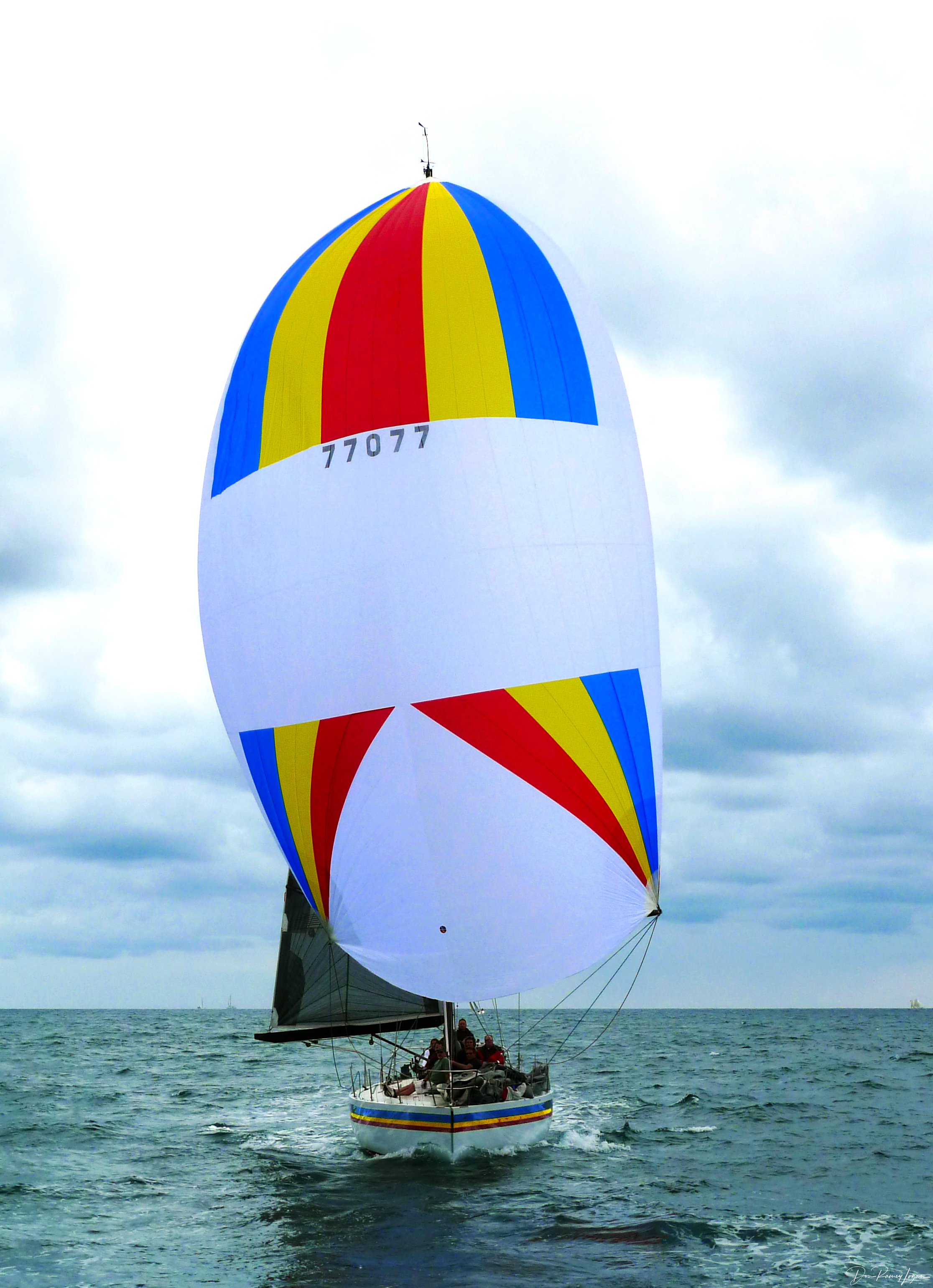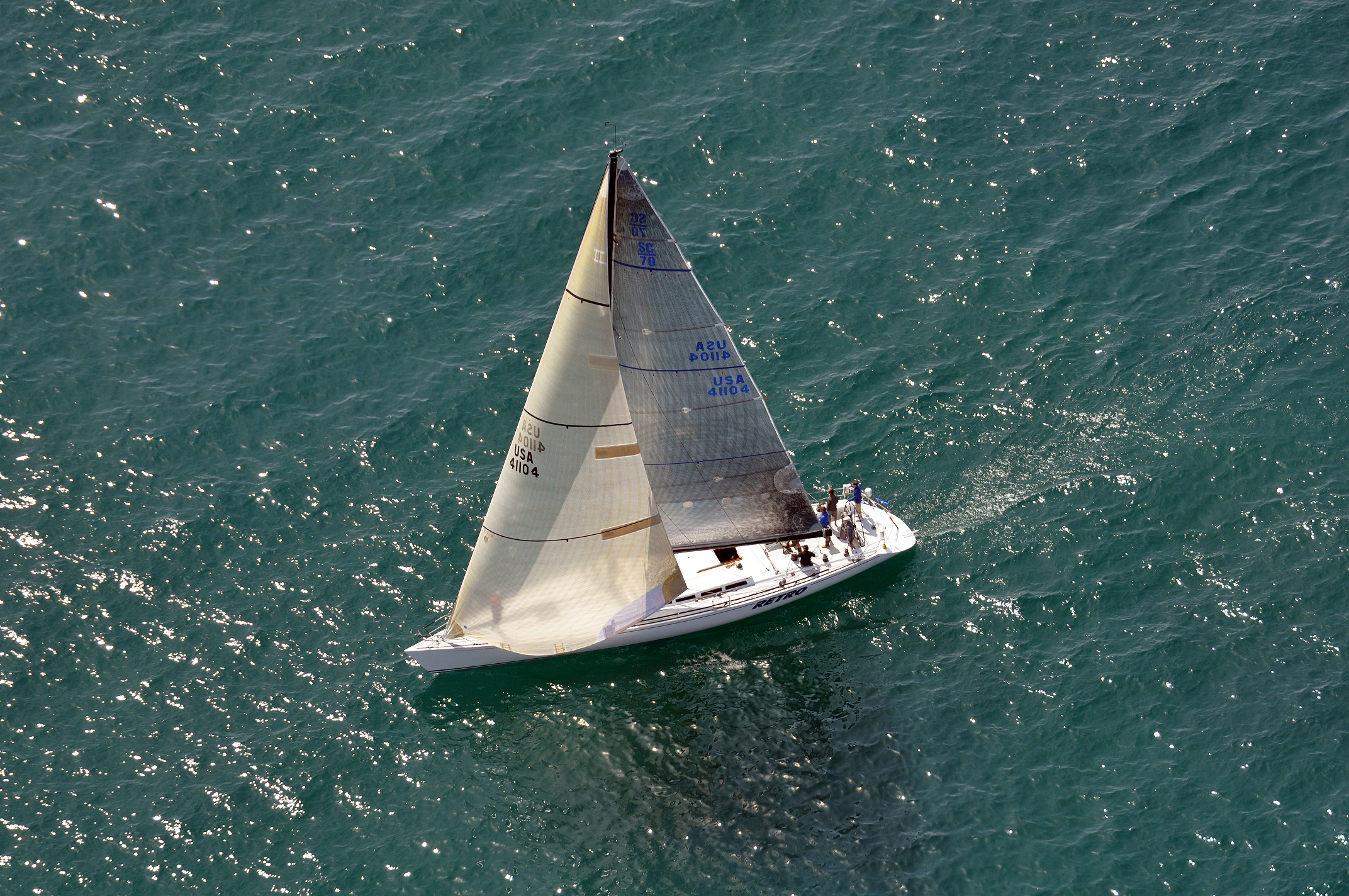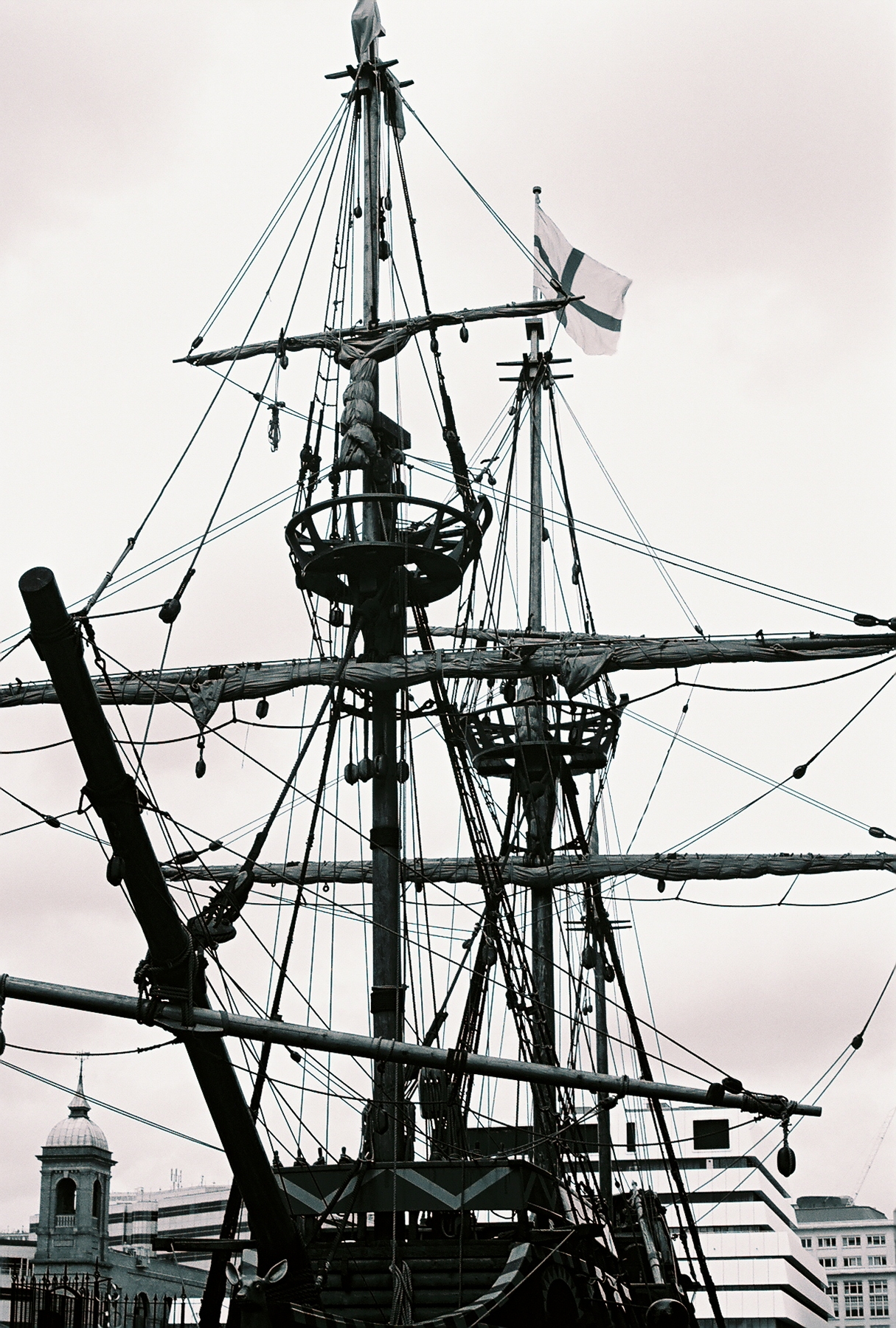|
Boomerang 20
The Boomerang 20 is a sailboat that was designed by Eric Maizey in the late 1960s to race and cruise on Port Phillip in Melbourne Australia, sheltered water but choppy conditions. The original boats were built at the family home in Frankston with the assistance of the kids and neighbours in cold moulded ply. As interest grew and production increased, the majority were fibreglass construction. The hulls were built by contractors such as Bruce Orchard and fitted out at the Maizey home until the growing business took up residence in a factory in Kookaburra St. Frankston. Boomerangs began appearing at major regattas in increasing numbers, and their reputation for excellent sailing qualities and bulletproof design grew with their successful racing results. The class soon gained JOG qualification and so could race in the relevant offshore events. After Eric Maizey's untimely death, the business was sold and the Boomerang was built in Victoria, Australia, by Maison (Maizey and Son) Mari ... [...More Info...] [...Related Items...] OR: [Wikipedia] [Google] [Baidu] |
Masthead Rig
A masthead rig on a sailing vessel consists of a forestay and backstay both attached at the top of the mast. The Bermuda rig can be split into two groups: the masthead rig and the fractional rig. The masthead rig has larger and more headsails, and a smaller mainsail, compared to the fractional rig. The major advantage a masthead sloop has over a fractional one, is that the jib is larger. Since the jib has no mast in front of it to cause turbulent airflow over it, it is considered much more efficient than the main, especially for sailing up wind. Also, since the fore stay is attached to the top of the mast, it pulls directly against the back stay. Tightening the back stay, then, increases the tension on the fore stay. This is useful because the jib needs considerable fore stay tension to set well. This need increases in direct proportion to the wind speed and jib size. Increasing the tension on the back stay does not tend to bend the mast, as it would on a fractional sloop. It pu ... [...More Info...] [...Related Items...] OR: [Wikipedia] [Google] [Baidu] |
Sailing In Australia
Sailing is a popular sport and recreational activity in Australia with its varied coastline and often warm climate. Australian Sailing is the peak body in charge of sailing as recognised by the International Sailing Federation In 2017-18 there were over 80,000 registered sailors and over 16,000 events held across the country. Clubs Sailing Clubs are common in Australia. Large cities have significant numbers of clubs catering to boats from off the beach dinghys to serious ocean racing. Sydney for example, has over 40 sailing clubs. Most moderate sized towns with sailable water nearby have a sailing club. Many clubs hold weekly races, annual championships and annual races. Sailing Associations Australia has a large number associations ranging from one design class associations, which sail boats bound by strict rules to open associations for development and broad communities of boats. Associations are generally at a national level with state based subsidiaries, although some assoc ... [...More Info...] [...Related Items...] OR: [Wikipedia] [Google] [Baidu] |
Portsmouth
Portsmouth ( ) is a port and city in the ceremonial county of Hampshire in southern England. The city of Portsmouth has been a unitary authority since 1 April 1997 and is administered by Portsmouth City Council. Portsmouth is the most densely populated city in the United Kingdom, with a population last recorded at 208,100. Portsmouth is located south-west of London and south-east of Southampton. Portsmouth is mostly located on Portsea Island; the only English city not on the mainland of Great Britain. Portsea Island has the third highest population in the British Isles after the islands of Great Britain and Ireland. Portsmouth also forms part of the regional South Hampshire conurbation, which includes the city of Southampton and the boroughs of Eastleigh, Fareham, Gosport, Havant and Waterlooville. Portsmouth is one of the world's best known ports, its history can be traced to Roman times and has been a significant Royal Navy dockyard and base for centuries. Portsm ... [...More Info...] [...Related Items...] OR: [Wikipedia] [Google] [Baidu] |
PHRF
Performance Handicap Racing Fleet (PHRF) is a handicapping system used for yacht racing in North America. It allows dissimilar classes of sailboats to be raced against each other. The aim is to cancel out the inherent advantages and disadvantages of each class of boats, so that results reflect crew skill rather than equipment superiority. PHRF is used mainly for larger sailboats (i.e., 7 meters and above). For dinghy racing, the Portsmouth yardstick handicapping system is more likely to be used. The handicap number assigned to a class of yachts is based on the yacht's speed relative to a theoretical yacht with a rating of 0. A yacht's handicap, or rating, is the number of seconds per mile traveled that the yacht in question should be behind the theoretical yacht. Most boats have a positive PHRF rating, but some very fast boats have a negative PHRF rating. If Boat A has a PHRF rating of 15 and Boat B has a rating of 30 and they compete on a 1 mile course, Boat A should finish a ... [...More Info...] [...Related Items...] OR: [Wikipedia] [Google] [Baidu] |
Spinnaker
A spinnaker is a sail designed specifically for sailing off the wind on courses between a reach (wind at 90° to the course) to downwind (course in the same direction as the wind). Spinnakers are constructed of lightweight fabric, usually nylon, and are often brightly colored. They may be designed to perform best as either a reaching or a running spinnaker, by the shaping of the panels and seams. They are attached at only three points and said to be ''flown''. Nomenclature Informal names for a spinnaker are ''kite'' or ''chute'' (owing to their resemblance to a parachute in both construction and appearance). Boats may have more than one spinnaker, differentiated by a letter to indicate symmetric (S) or asymmetric (A) and a number to indicate size (with higher numbers indicating smaller size), e.g. ''A1'' would be a large asymmetric sail and ''S3'' would be a smaller symmetric sail. Operation A spinnaker is used for sailing with the direction of the wind. Symmetrical ... [...More Info...] [...Related Items...] OR: [Wikipedia] [Google] [Baidu] |
Genoa (sail)
A genoa sail is a type of large jib or staysail that extends past the mast and so overlaps the main sail when viewed from the side, sometimes eliminating it. It was originally called an "overlapping jib" and later a genoa jib. It is used on single-masted sloops and twin-masted boats such as yawls and ketches. Its larger surface area increases the speed of the craft in light to moderate winds; in high wind, a smaller jib is usually substituted, and downwind a spinnaker may be used. Definition The term ''jib'' is the generic term for any of an assortment of ''headsails''. The term ''genoa'' (or genny) refers to a type of jib that is larger than the 100% foretriangle, which is the triangular area formed by the point at which the stay intersects the mast, and deck or bowsprit, and the line where the mast intersects deck at the rail. Colloquially the term is sometimes used interchangeably with ''jib''. A working jib is no larger than the 100% foretriangle. A genoa is larger, with ... [...More Info...] [...Related Items...] OR: [Wikipedia] [Google] [Baidu] |
Mainsail
A mainsail is a sail rigged on the main mast of a sailing vessel. * On a square rigged vessel, it is the lowest and largest sail on the main mast. * On a fore-and-aft rigged vessel, it is the sail rigged aft of the main mast. The sail's foot is normally attached to a boom. (In extremely heavy weather, the mainsail may be lowered, and a much smaller trysail hoisted in its place). Historical fore-and-aft rigs used a four-sided gaff rigged mainsail, sometimes setting a gaff topsail above it. Whereas once the mainsail was typically the largest sail, today the mainsail may be smaller than the jib or genoa; Prout catamarans typically have a mainmast stepped further aft than in a standard sloop, so that the mainsail is much smaller than the foresail. Bermuda rig The modern Bermuda rig uses a triangular mainsail aft of the mast, closely coordinated with a jib for sailing upwind. A large overlapping jib or genoa is often larger than the mainsail. In downwind conditions (with t ... [...More Info...] [...Related Items...] OR: [Wikipedia] [Google] [Baidu] |
Sail
A sail is a tensile structure—which is made from fabric or other membrane materials—that uses wind power to propel sailing craft, including sailing ships, sailboats, windsurfers, ice boats, and even sail-powered land vehicles. Sails may be made from a combination of woven materials—including canvas or polyester cloth, laminated membranes or bonded filaments—usually in a three- or four-sided shape. A sail provides propulsive force via a combination of lift and drag, depending on its angle of attack—its angle with respect to the apparent wind. Apparent wind is the air velocity experienced on the moving craft and is the combined effect of the true wind velocity with the velocity of the sailing craft. Angle of attack is often constrained by the sailing craft's orientation to the wind or point of sail. On points of sail where it is possible to align the leading edge of the sail with the apparent wind, the sail may act as an airfoil, generating propulsive force as air p ... [...More Info...] [...Related Items...] OR: [Wikipedia] [Google] [Baidu] |
Mast (sailing)
The mast of a sailing vessel is a tall spar, or arrangement of spars, erected more or less vertically on the centre-line of a ship or boat. Its purposes include carrying sails, spars, and derricks, and giving necessary height to a navigation light, look-out position, signal yard, control position, radio aerial or signal lamp. Large ships have several masts, with the size and configuration depending on the style of ship. Nearly all sailing masts are guyed. Until the mid-19th century, all vessels' masts were made of wood formed from a single or several pieces of timber which typically consisted of the trunk of a conifer tree. From the 16th century, vessels were often built of a size requiring masts taller and thicker than could be made from single tree trunks. On these larger vessels, to achieve the required height, the masts were built from up to four sections (also called masts). From lowest to highest, these were called: lower, top, topgallant, and royal masts. Giving the ... [...More Info...] [...Related Items...] OR: [Wikipedia] [Google] [Baidu] |
Sloop
A sloop is a sailboat with a single mast typically having only one headsail in front of the mast and one mainsail aft of (behind) the mast. Such an arrangement is called a fore-and-aft rig, and can be rigged as a Bermuda rig with triangular sails fore and aft, or as a gaff-rig with triangular foresail(s) and a gaff rigged mainsail. Sailboats can be classified according to type of rig, and so a sailboat may be a sloop, catboat, cutter, ketch, yawl, or schooner. A sloop usually has only one headsail, although an exception is the Friendship sloop, which is usually gaff-rigged with a bowsprit and multiple headsails. If the vessel has two or more headsails, the term cutter may be used, especially if the mast is stepped further towards the back of the boat. When going before the wind, a sloop may carry a square-rigged topsail which will be hung from a topsail yard and be supported from below by a crossjack. This sail often has a large hollow foot, and this foot is sometimes fil ... [...More Info...] [...Related Items...] OR: [Wikipedia] [Google] [Baidu] |
Rigging
Rigging comprises the system of ropes, cables and chains, which support a sailing ship or sail boat's masts—''standing rigging'', including shrouds and stays—and which adjust the position of the vessel's sails and spars to which they are attached—the ''running rigging'', including halyards, braces, sheets and vangs. Etymology According to the Encyclopædia Britannica Eleventh Edition "rigging" derives from Anglo-Saxon ''wrigan'' or ''wringing'', "to clothe". The same source points out that "rigging" a sailing vessel refers to putting all the components in place to allow it to function, including the masts, spars, sails and the rigging. Types of rigging Rigging is divided into two classes, ''standing'', which supports the mast (and bowsprit), and ''running'', which controls the orientation of the sails and their degree of reefing. Configurations differ for each type of rigging, between ''fore-and-aft rigged'' vessels and ''square-rigged'' vessels. Standing Standin ... [...More Info...] [...Related Items...] OR: [Wikipedia] [Google] [Baidu] |

.jpg)
2009.jpg)




.jpg)
